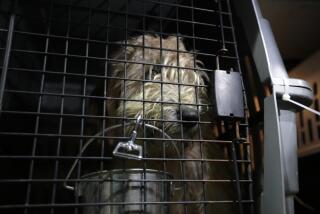‘Dummy’ Air Bags Are Putting Drivers in Peril
- Share via
Air bags can save your life--if they work.
But some unwitting car owners have time bombs, not safety cushions, lurking inside their steering wheels.
For the record:
12:00 a.m. Oct. 1, 1999 For the Record
Los Angeles Times Friday October 1, 1999 Home Edition Business Part C Page 3 Financial Desk 1 inches; 30 words Type of Material: Correction
Air bags--A Business section graphic Saturday incorrectly described part of the process that makes automobile air bags inflate. When sodium azide pellets are heated, they produce nitrogen, which fills the air bag.
Unscrupulous auto repair shops are installing spent or stolen air bags in customers’ cars, charging $1,000 or more for safety systems that will not respond in accidents, police, insurers and consumer groups say.
Appalled by such reports, the California Legislature recently passed a bill that makes it a crime to sell previously deployed air bags. Violators face up to a year in prison and $5,000 fines. Gov. Gray Davis signed the measure into law this week.
“This is designed to help protect consumers from unscrupulous auto shops and junkyards,” said Assemblywoman Sally Havice (D-Cerritos), who coauthored the bill. “There has been no way to prosecute them. People really need to know they can be ripped off this way.”
Businesses that traffic in so-called dummy air bags--many of them stolen or taken from salvaged wrecks--are causing big headaches for police and insurance companies. The sensitive systems that tell bags when to inflate often fail when the devices are transplanted from car to car, even if they have never been deployed, experts say.
Air bag thefts increased more than 50% in the U.S. between 1995 and 1998, from 32,400 a year to about 50,000, and now cost insurers about $120 million annually.
The gray market for the devices expanded dramatically in 1997, when the federal government mandated that all U.S.-made autos have dual air bags.
Thieves typically sell air bags to auto body shops for about $200, said Stephanie Macadaan, communications manager for the Western Insurance Information Service, an industry group. Then the shops bill insurers or consumers from $1,000 to $2,000, what new air bags typically cost, she said.
Prosecutors have filed cases against businesses in New York and Detroit, accusing them of stealing air bags and selling them to repair shops. In August, police busted a Van Nuys ring blamed for swiping dozens, possibly hundreds, of bags.
But California authorities had no legal recourse against shady operators who defraud consumers and insurers by installing dummy bags--until now.
“It gives us a little bit more to go into these shops,” Los Angeles Police Det. Bob Graybill said. “It’s a major, major problem in the San Fernando Valley, where there are probably more body shops and dismantling shops than anywhere in L.A.”
For consumers, spotting phony air bags is almost impossible.
Only the tiniest tip-offs alert car owners to tampering, said Sam Massey, director of field operations for Supplemental Restraint Specialists Inc., a Long Beach company that specializes in replacing air bags in wrecked cars.
Even experts can overlook subtle signs such as uneven paint on the steering wheel or a dashboard warning light that fails to flicker on and off.
“I know a Ford dealership that just got faked out,” Massey said. “They bought a used car from some guy, then realized he’d had dummy air bags put in.”
Because each type of car has a unique crash pulse that tells its air bag when to inflate, the devices often do not work if transferred from one make to another. Manufacturing adjustments made from year to year mean that an air bag made for a 1997 model may not work in the 1998 version of the same car.
“The littlest thing could make it not deploy or deploy when it isn’t supposed to,” said Julie Rochman, vice president of communications for the Insurance Institute for Highway Safety. “It isn’t like sparkplugs or sheet metal. Air bags come from the factory in a precise pattern.”
At least six civil lawsuits are pending nationwide in which consumers bought cars that, unbeknown to them, had dummy air bags, Massey said. The devices did not work properly in subsequent collisions.
Even if suspect air bag systems never face real-life crash tests, they can harm less savvy consumers.
Diane Glosson of Burbank said she bought a used Toyota Celica even though the seller told her the car’s air bags were spent or missing. The seller assured her she could replace the mechanisms for about $1,000.
Then Glosson found out the car had been wrecked, its air bag system plundered for parts, and the repair would cost more than $4,000. She plans to resell the car instead, disclosing its air bag problems upfront to potential buyers.
“That’ll be a real selling point, won’t it?” she said. “You shouldn’t be allowed to sell cars without [working] air bags if they’re designed to have them.”
California’s law stops short of that, but it places new responsibilities on air bag suppliers and auto repairers. New York City passed a similar ordinance in 1995 requiring body shops to certify that the air bags they installed had not previously deployed.
Even with the new law in place, consumers still should take used cars for diagnostic checkups before buying them and should avoid repair shops that offer rebuilt air bags at discount prices, Graybill and Massey agreed.
“You wouldn’t buy a parachute from a junkyard,” Massey said. “You shouldn’t buy an air bag from one either.”
(BEGIN TEXT OF INFOBOX / INFOGRAPHIC)
No Reused Air Bags
A state bill would make it a crime to sell previously deployed air bags. Some repair shops install spent or inappropriate air bags in customers’ vehicles.
How Air Bags Deploy
1. Sensors/control module electronically connected to air bag
2. If car suddenly slows, sensor activates firing mechanism that inflates air bag with gas (sodium azite)
What to Look Out For
* Dashboard warning light: When you turn on the ignition, the air bag warning light on the dashboard should flicker on and off. If it never comes on, someone may have removed the lightbulb to prevent the car’s sensors from warning you that something is amiss.
* Air bag cover: Check your steering wheel for any imperfections or evidence of repainting such as rough spots, color changes, drips. They may signal a cosmetic repair.
* Offers to cover your deductible: Beware if a body shop offers to waive your deductible. They may plan to make up the difference by installing dummy air bags--a way to cut corners invisible to the customer’s eye.
* Huge price discounts: New driver’s side air bags retail for about $500; passenger side bags cost $500 to $1,000. If a shop offers you bags for $250, there’s something wrong.
Source: Supplemental Restraint Specialists Inc.






